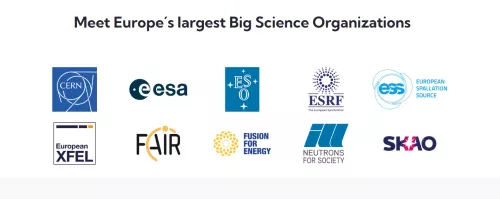

ABOUT THE BSOs: THE BIG SCIENCE ORGANIZATIONS SHOW UP!
Über die Organisation
The Big Science Organisations, shortly known as BSOs, are the Organizers of the Big Science Business Forum, a dedicated business oriented congress, focused on high technology and innovation with the aim to be the main meeting point between Research Infrastructures and Industry in Europe.
In October 2024, Italy will host the third edition of the event in the city of Trieste (Friuli Venezia Giulia, Italy).
Then, are you curious about the BSOs activities and structures?
Let’s discover the largest Big Science Organizations (BSOs) in Europe, read more about their mission and understand why they are so relevant for the future and the lives of all of us!
BSOs are mostly qualified as public bodies and agencies, with offices throughout Europe, which initiate public selection procedures through opportunities that can be consulted and accessed directly from dedicated sections within their portals.
Career opportunities within BSOs are of a diverse nature and may require different skills and experience, in the fields of research, science, engineering and technology, physics, but also communication, human resources, economics and management!
A wide range of career possibilities for students, graduates and experienced professionals: from traineeships and apprenticeships to PhDs, and more!
A very wide range of profiles and professions then, and below, a brief introduction to their activities and the links to their webportals.
CERN
Our mission is to:
- perform world-class research in fundamental physics.
- provide a unique range of particle accelerator facilities that enable research at the forefront of human knowledge, in an environmentally responsible and sustainable way.
- unite people from all over the world to push the frontiers of science and technology, for the benefit of all.
- train new generations of physicists, engineers and technicians, and engage all citizens in research and in the values of science.
ESA – EUROPEAN SPACE AGENCY
The European Space Agency (ESA) is Europe's gateway to space. Its mission is to shape the development of Europe's space capability and ensure that investment in space continues to deliver benefits to the citizens of Europe and the world. ESA is an international organisation with 22 Member States.
In short, ESA’s job is to draw up the European space programme and carry it through. ESA's programmes are designed to find out more about Earth, its immediate space environment, our Solar System and the Universe, as well as to develop satellite-based technologies and services, and to promote European industries. ESA also works closely with space organisations outside Europe.
ESO - European Southern Observatory
ESO is the pre-eminent intergovernmental science and technology organisation in astronomy. It carries out an ambitious programme focused on the design, construction and operation of powerful ground-based observing facilities for astronomy, in order to enable important scientific discoveries. ESO also plays a leading role in promoting and organising cooperation in astronomical research.
F4E - FUSION FOR ENERGY
F4E counts more than 450 members of staff, mostly engineers, physicists, project managers and specialised administrative staff, engaged in delivering Europe’s contribution in the various projects involved. F4E has offices in four different locations across the world: Barcelona (Spain), Cadarache (France), Garching (Germany) and Rokkasho (Japan).
ESRF – The European Synchrotron Radiation Facility France
With a brand-new generation of high-energy synchrotron, the ESRF is the world's brightest synchrotron light source and a centre of excellence for fundamental and innovation-driven research in condensed and living matter science. Located in Grenoble, France, the European Synchrotron owes its success to the international cooperation of 21 partner countries.
ESS – European Spallation Source
The European Spallation Source, a partnership of European countries, is hiring motivated and inspired people to plan, design, and construct the world’s most powerful neutron source. As one of the largest active infrastructure projects in Europe, our team attracts leaders in science and engineering from all over the world. We seek ambitious, talented people who are excited about playing a part in the future of science in Europe.
EUROPEAN XFEL
European XFEL offers ultrashort X-ray pulses of outstanding spatial coherence and spectral brilliance. In collaboration with international user communities, especially from our shareholder countries, we perform world-class experiments for a broad range of scientific applications. By creating research opportunities, developing novel scientific methods, and pioneering beyond state-of-the-art technologies, we strengthen the competitiveness of European science. As a culturally diverse workforce with a collaborative spirit we place user support, research and knowledge transfer at the core of our mission.
The European XFEL comprises a superconducting electron accelerator, magnet structures for the generation of the X-ray radiation, photon beamlines, and scientific instruments for a wide range of experimental techniques.
FAIR - Facility for Antiproton and Ion Research
The international accelerator facility FAIR, one of the largest research projects worldwide. FAIR and GSI offer a variety of different job opportunities, e. g. in our workshops, our electronic labs, in vacuum technology, IT and many more. You will always deal with technology at the state of science.
To perform world-class science we depend on highly qualified personnel.
For the many students and PhD candidates conducting experiments at the accelerator facility GSI and FAIR offer special programs.
ILL - Institut Laue-Langevin NEUTRONS FOR SOCIETY
The Institut Laue-Langevin (ILL) is funded and managed by France, Germany and the United Kingdom, in partnership with 11 other European countries.
The research conducted at the ILL is dedicated to both fundamental science (60%) and the modern societal challenges (40%). It covers topics in biology, (green) chemistry and materials science, as well as condensed matter, nuclear and particle physics.
SKAO - Square Kilometre Array Observatory
The SKAO is a next-generation radio astronomy-driven Big Data facility that will revolutionise our understanding of the Universe and the laws of fundamental physics. Enabled by cutting-edge technology, it promises to have a major impact on society, in science and beyond.
The SKA Observatory, or SKAO for short, is an intergovernmental organisation bringing together nations from around the world.
Its mission is to build and operate cutting-edge radio telescopes to transform our understanding of the Universe, and deliver benefits to society through global collaboration and innovation.
The observatory has a global footprint and consists of the SKAO Global Headquarters in the UK, the SKAO’s two telescopes at radio-quiet sites in South Africa and Australia, and associated facilities to support the operations of the telescopes.
Constructing and operating these telescopes will position the SKAO as the leading research infrastructure for radio astronomy globally, providing science capabilities to the international astronomical community for decades to come.
ILOs Industrial Liaison Officers
- PERIIA Network
Ana Belén del Cerro Gordo – CDTI, Chair of PERIIA
- Danish ILO
Nikolaj Zangenberg – DTI, ILO for CERN
- Spanish ILO
Javier Echávarri – CDTI, ILO for ESO, SKA
- ILO Network Italia
Francesco D’Acapito – CNR, ILO for ESFR & XFEL
Mauro Morandin – INFN, ILO for CERN
Elisabetta Narducci – CNR, ILO for ESRF
Corrado Perna – INAF, ILO for ESO & SKAO


